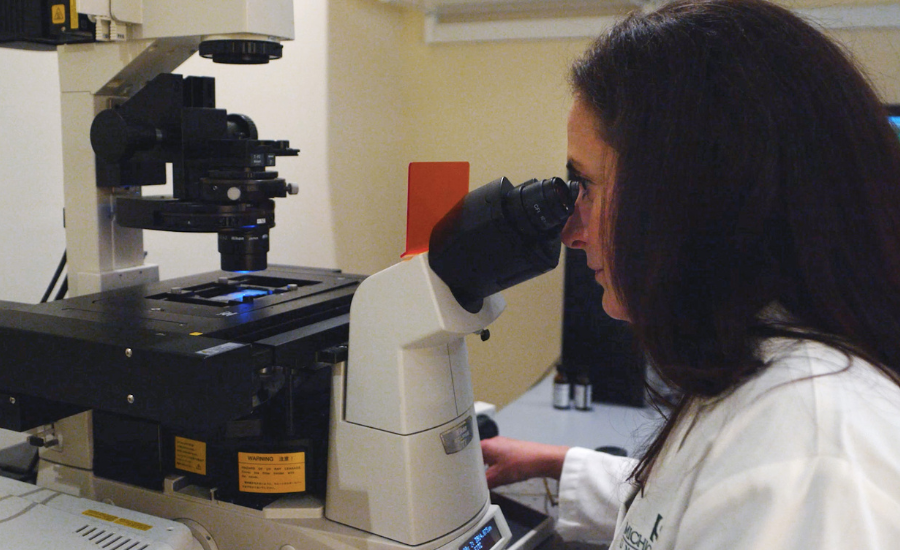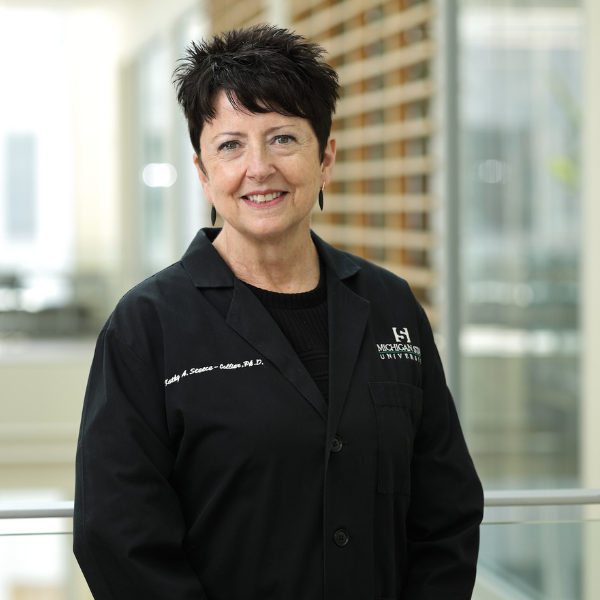New Therapeutic Offers Hope for Patients with Parkinson’s Disease
September 25, 2024
As she studied a possible treatment intended to reduce a side effect of the medication commonly prescribed for Parkinson’s patients, Kathy Steece-Collier was surprised by what she saw.
In pre-clinical research, their novel treatment – a type of gene therapy – not only reduced or eliminated the side effect but appeared to reverse many Parkinson’s symptoms in the absence of any medication. Their evidence also suggests this therapy has potential to halt progression of the disease.
“I was dumbfounded,” Steece-Collier, PhD, a professor of translational neuroscience, said. “It shows promise that I have not seen in my 30-year career. It in essence appears to turn back the hands of time.”
She cautioned that the therapy still must pass a series of lengthy clinical trials, which could take many years, before it can be widely offered to Parkinson’s patients at all stages of the disease.
Doctors commonly prescribe a drug called levodopa to alleviate the tremors, stiffness, and other motor symptoms characteristic of Parkinson’s, but long-term use can cause a side effect called dyskinesia, the involuntary and uncontrolled movement of hands, the head, and other body parts. In addition, while levodopa and other Parkinsonian medications can be very beneficial, they do not address all symptoms and lose effectiveness as the disease progresses.
For decades, Steece-Collier has led an effort to reduce or eliminate dyskinesia and improve the quality of life for Parkinson’s patients.  In this quest, her team’s research focused on cells called medium spiny neurons (MSN) in an area of the brain called the striatum. MSN cells have appendages called dendrites, and each dendrite is covered with minute spines, which have receptors for dopamine, a neuro chemical that declines in Parkinson’s and is necessary for normal motor movement.
In this quest, her team’s research focused on cells called medium spiny neurons (MSN) in an area of the brain called the striatum. MSN cells have appendages called dendrites, and each dendrite is covered with minute spines, which have receptors for dopamine, a neuro chemical that declines in Parkinson’s and is necessary for normal motor movement.
In Parkinson’s patients, as the dopamine declines, the minute spines retract. Levodopa, a synthetic form of dopamine, commonly prescribed as Sinemet, stimulates the regrowth of spines, but the new spines appear to lack the ability to form normal brain circuits, resulting in the development of dyskinesia.
The “right amount” of calcium is necessary for the normal functioning of brain cells, Steece-Collier said, but research has shown that the loss of dopamine causes a calcium channel in MSN cells called CaV1.3 to allow too much calcium into the spines, leading to retraction of the spines. In another brain region, the substantia nigra, where dopamine producing neurons die off in Parkinson’s, CaV1.3 channels and chronic influx of calcium is involved with their cell death. Reducing CaV1.3 channels in both MSN and substantia nigra cells has potential to benefit Parkinson’s patients. A couple of drugs can block CaV1.3 but getting a large enough dose into the brain risks serious side effects involving other unintended brain regions and the cardiovascular system. A better approach, Steece-Collier believes, is using a harmless virus to introduce genetic ‘silencing’ material into the specific brain region of interest.
Fredric Manfredsson, PhD, a former MSU professor now at Barrow Neurological Institute in Phoenix, created a viral vector (a harmless virus stripped of its ability to reproduce) to act as a Trojan horse to carry a bit of genetic material called shRNA into the striatum and turn down the production of the CaV1.3 calcium channels.
As hoped, their therapy, delivered to the striatum, does alleviate dyskinesia in laboratory research, Steece-Collier said, but it also reverses symptoms, such as postural instability and apathy, and prevents the loss of levodopa function common in Parkinson’s patients.
Stopping dyskinesia, she said, was “the frosting on the cake.”
The cake was the unanticipated reversal of symptoms in the absence of medication, expanding the function of levodopa, and evidence of its promise to halt of the disease’s progression.
Working with MSU’s Spartan Innovation, Steece-Collier and Manfredsson founded a startup company called CavGene Therapeutics, Inc., to apply for grants that will support research directed specifically at developing a viral vector that is safe in human patients.
In a field long dominated by men, Steece-Collier is proud that her lab is staffed entirely by a group of “very talented women scientists who are pushing this research forward.”
Their goal is to render Parkinson’s a treatable disease where symptoms can be minimized and effectively managed, thereby improving the quality of life for patients. This new therapeutic offers hope that some patients might not need to take medication at all, and, for those who do, the medication might continue working indefinitely without the debilitating side effect of dyskinesia.
“Honestly, in my wildest dreams I couldn’t imagine a single therapeutic having this much benefit,” Steece-Collier said. “If our laboratory research findings translate to individuals with Parkinson’s, I really think this will be a game changer for the clinical management of Parkinson’s disease.”
By Pat Shellenbarger
Related News ![]()
In 2023, MSU scientists create start-up to develop gene therapy for people with Parkinson's disease.


